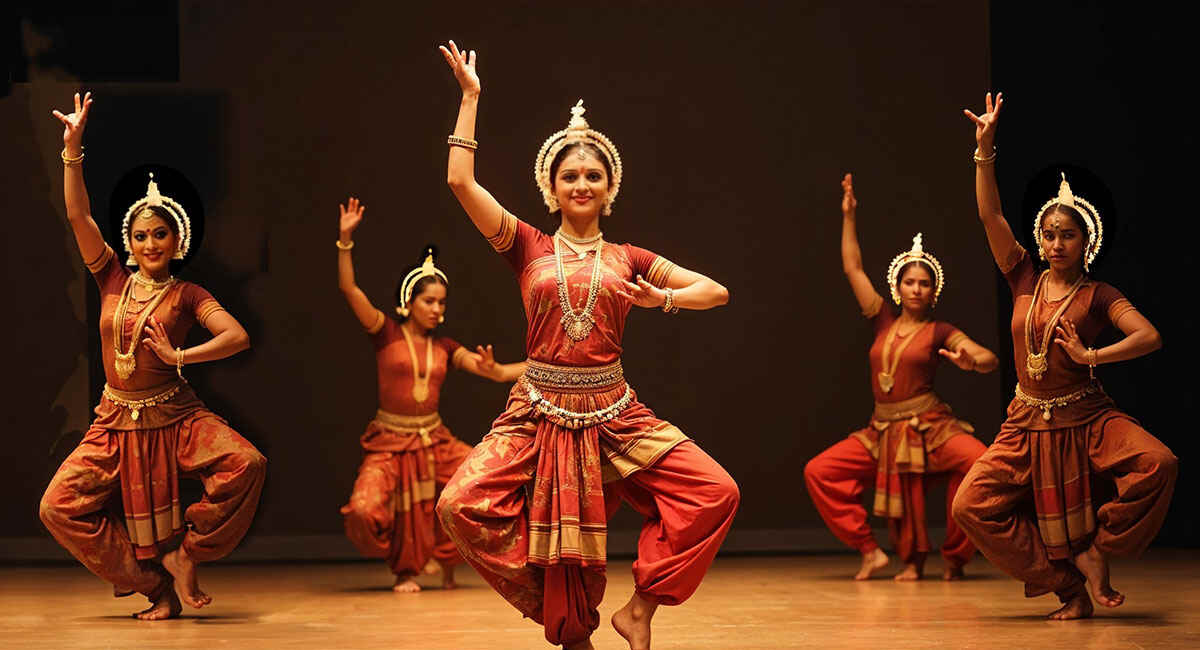The Storytelling Steps in Odissi Dance
Odissi dance, one of India’s eight classical dance forms, is not just a sequence of graceful movements — it’s a rich tapestry of stories woven through intricate gestures, rhythmic patterns, and expressive emotions. Known for its spiritual roots and aesthetic elegance, Odissi originates from the state of Odisha and has a profoundly narrative essence. At the heart of every performance lies a story, often drawn from Indian mythology, expressed through what we call “Abhinaya” — the art of storytelling in dance.
In this blog, we’ll explore the storytelling steps in Odissi dance and how this ancient art form brings narratives to life.
The Foundation of Storytelling in Odissi
The foundation of storytelling in Odissi lies in Natya Shastra, the ancient Sanskrit text on performing arts. According to this text, dance is not merely entertainment but a powerful form of communication. Odissi follows this principle closely, blending Bhava (emotion), Raga (melody), Tala (rhythm), and Abhinaya (expression) to narrate stories.
Odissi stories are often devotional and revolve around deities such as Lord Krishna, Lord Jagannath, and Goddess Durga. Dancers narrate these tales through two key components: Nritta (pure dance) and Nritya (expressive dance). While Nritta showcases rhythm and technical skill, Nritya focuses on storytelling through expression.
The Language of Mudras
A crucial element in the narrative structure of Odissi is the use of mudras — symbolic hand gestures that act like sign language. There are two types:
- Asamyuta Hastas (single-hand gestures)
- Samyuta Hastas (double-hand gestures)
Each mudra conveys a specific meaning. For example:
- The “Pataka” mudra (open palm) can symbolize clouds, forests, or even blessings.
- Dancers often use the “Shikhara” mudra (thumb up, fingers closed) to show a bow or represent Lord Shiva.
By combining mudras with body movements and facial expressions, dancers create a vivid storytelling experience.
Facial Expressions Bringing Emotions to Life
Odissi dancers are masters of facial expressions, or “mukhaja abhinaya.” These expressions breathe life into the stories and convey love, fear, devotion, anger, and joy.
For example, in stories about Radha and Krishna, a dancer might show Radha’s longing through soft eyes, a gentle smile, and a subtle tilt of the head. In contrast, a scene depicting a demon’s rage would feature wide eyes, furrowed brows, and strong, aggressive movements. These terms allow even someone unfamiliar with the mythology or language to relate to the feelings and comprehend the plot.
Dance Pieces as Story Chapters
Odissi performances often follow a traditional structure with different pieces, each serving as a chapter in a story. Here are a few examples:
- Mangalacharan: The opening piece invokes the blessings of the gods. It’s like a prologue.
- Batu Nrutya or Pallavi: Pure dance segments that display the dancer’s technique and rhythm.
- Abhinaya: The central storytelling portion, where the dancer interprets lyrics from Sanskrit or Odia poetry.
- Moksha: The final piece, symbolizing liberation and spiritual bliss.
Among these, Abhinaya is the most narrative-driven. Dancers interpret poetry from works like Jayadeva’s Geeta Govinda. These poems celebrate divine love and are a rich source of Odissi storytelling.
Costume and Music, Enhancing the Story
Odissi costumes, jewelry, and music are not just decorative elements but are essential to the narrative. The traditional sambalpuri or bomkai saree worn in a specific style reflects regional heritage. The dancer’s elaborate silver jewelry and Chandrika (crown-like headpiece) help embody divine characters.
Based on Odissi classical ragas, musicians perform Odissi music using traditional instruments like the mardala (percussion), flute, violin, and manjira (cymbals). The lyrics are usually in Sanskrit or Odia and form the script for the dancer to narrate.
Symbolism in Movement
Even the simplest movement in Odissi is symbolic. The tribhangi posture (dividing the body into three bends — at the neck, waist, and knee) is central to Odissi and represents both aesthetic beauty and divine form. The chauka position symbolizes Lord Jagannath and the stability of the earth. These postures and movements are more than technique—they become the medium through which the story is told, whether it’s Krishna’s playful leelas or Goddess Durga’s fierce battles.
Modern Interpretations of Traditional Tales
Many contemporary dancers now explore modern themes using traditional storytelling steps, even though classical Odissi stories often draw from mythology. These might include social issues, environmental concerns, or even personal narratives. By adapting old techniques to new stories, Odissi remains a living, evolving art form that continues to speak to audiences across generations.
The Dance That Speaks
Odissi is more than movement — it is a dialogue between the dancer and the audience. Every gesture, glance, and step carries meaning. From divine love to cosmic battles, inner turmoil to spiritual awakening, Odissi narrates stories that transcend time and language.
As viewers, we are not just spectators. We become part of the story, feeling every emotion, understanding every nuance, and walking every step of the narrative path the dancer lays before us. The storytelling steps of Odissi are not just choreography — they are poetry in motion, a timeless dance of devotion, culture, and expression.


